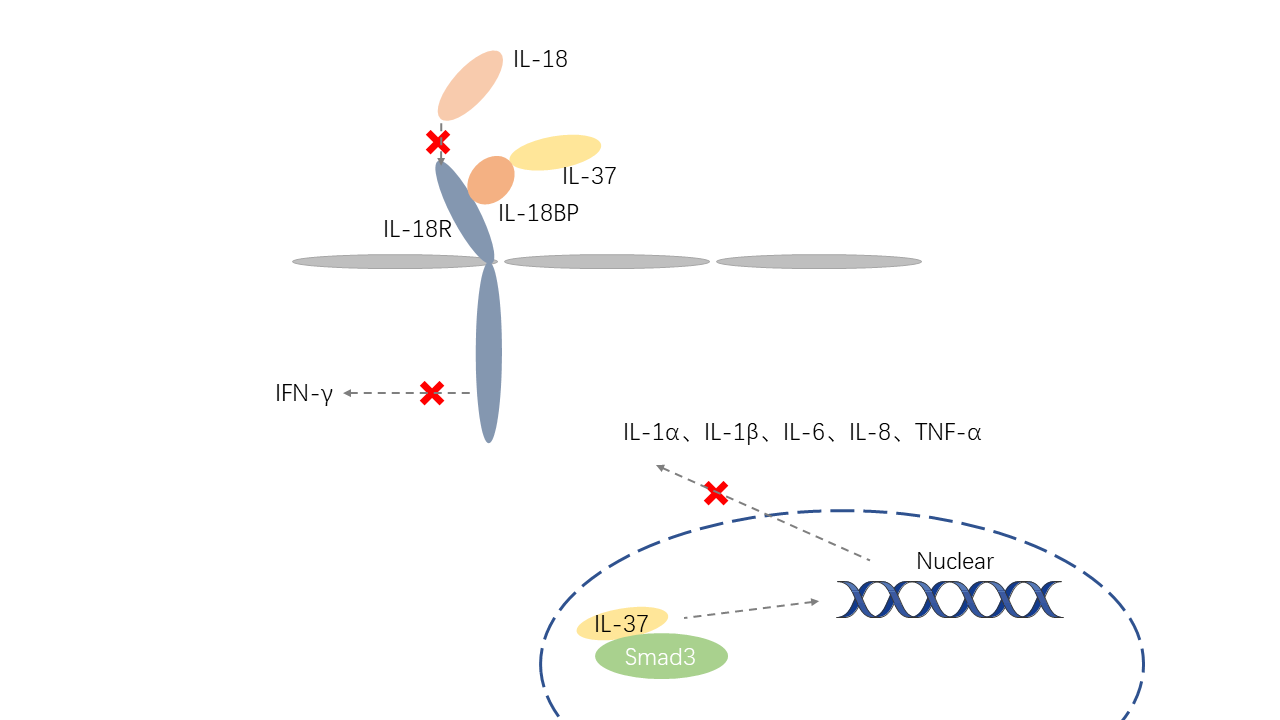Introduction
Interleukin-37 is a member of the IL-1 family, which inhibits the expression of a variety of inflammatory factors and may protect the body from itself in autoimmune diseases, as well as in infectious diseases induced by pathogenic organisms such as endotoxins, viruses and fungi.IL-37 exists in 5 splice mutants, IL-37a- IL-37e. IL-37a, b, and c are expressed mainly in lymph nodes, thymus, bone marrow, lung, testis, monocytes, keratinocytes, and post-stimulation B cells, while IL-37d and e are expressed only in bone and testis. Of these, IL-37b is the most complete subtype, and mature IL-37b is able to enter the nucleus and bind to small mother against decapentaplegic(Smad3), thereby influencing the function of gene transcription.
Mechanism and Function
IL-37b is able to bind to IL-18Rα or IL-8 binding protein. However, IL-37b has a slightly higher affinity for IL-8BP, and binding of IL-37 to IL-18BP enhances IL-18BP's ability to inhibit IL-18, thereby prohibiting IFN-γ production and T-cell proliferation. IL-37 can also enter the nucleus and bind to Smad3 and inhibits the transduction of various signaling pathways, such as the phosphorylation of signal transducers and activators of transcription (STAT) 1-4, p38 mitogen-activated protein kinase (MAPK), amino-terminal kinase c-Jun (JNK) signaling pathway, thereby reducing the production of IL-1α, IL-1β, IL-6, IL-8, and TNF-α. The combination of IL-37 and Smad3 also enhances the biological role of the cytokine TGF-β, which promotes bone repair. So there is a relationship between IL-37 and bone repair.
IL-37 is related to many diseases. As a cytokine involved in innate immunity and adaptive immunity, IL-37 inhibits excessive immune response through negative feedback during the onset of rheumatoid arthritis. And as an anti-inflammatory cytokine, IL-37 can inhibit excessive inflammation in autoimmune diseases and protect the body itself, so it has a certain relationship with Crohn's disease, lupus erythematosus and other diseases. In addition, IL-37 can also counteract the effects of pro-inflammatory cytokines and promote the further development of obesity. The expression of IL-37 in the body can reduce the local and systemic inflammatory response associated with Concanavalin A-induced hepatitis. In addition to inhibiting inflammation, IL-37 can also reduce the damage caused by pathogens to the body. In bacterial infections, IL-37 can play an anti-inflammatory effect by inhibiting the expression of pro-inflammatory factors and down-regulating the activity of dendritic cells, thereby inhibiting the occurrence of septic shock. In fungal infections, IL-37 can reduce the NLP family, pyrin domain containing 3 (NLRP3) inflammasome pathway, and reduce the expression levels of IL-1β, IL-17a, IFN-γ, IL-10 and other cytokines, thereby playing an antibacterial effect.
 Fig 1. Mechanism of Signaling
Fig 1. Mechanism of Signaling
Creative Proteomics can provide cytokine detection platform for scientific research. According to different purposes, our dedicated analysts will customize exclusive solutions for you. We aim to provide customers with high-quality and convenient services to help you accelerate the progress of your project.
Our cytokine detection service includes but is not limited to:
- Quantitative and qualitative detection of cytokines in different species
- Quantitative and qualitative detection of cytokine antibodies
- Quantitative and qualitative detection of single/multiple cytokines
Sample requirements
- Sample Types-Blood, serum, plasma, cerebrospinal fluid, cell culture supernatant, tissue homogenate, cell culture medium, urine, tumor, etc.
- Sample Volume-It is optimal for at least 200µl of each sample. This volume allows for triplicate testing of each sample.
Our advantages:
- Efficient design: Multiplex reaction detecting in various methods are available, which can be selected according to different samples and requirements.
- Sensitive Detection: High-quality antibodies are used in the detection process to improve detection specificity and accuracy.
- Reliable results: The feedback results are professional and efficient
Technology platform:
We mainly provide the Luminex cytokine detection platform. Luminex uses fluorescently encoded microspheres with specific antibodies to different target molecules. The different microspheres can be combined freely to a certain extent so that up to 100 analytes can be tested multiple times simultaneously in a single experiment.
The Luminex cytokine assay platform has the following advantages:
- Multiple detection: simultaneous detection of 100 biological targets
- Short experiment time: 1-3 weeks
- High sensitivity: the lower limit of accurate quantification is as low as 0.1 pg/mL
- Save samples: only need a sample volume as low as 25 μL
- Time saving: the experiment process only takes 4 hours
For your different needs, we can also provide the following detection methods:
- Enzyme-linked immunosorbent assay (ELISA)
- Flow cytometry
Workflow

For more information about the IL-37 detection service or need other detection requirements, please contact us.
References:
- Nold-Petry C A, Zepp J A, Palmer B E, et al. IL-37 is a fundamental inhibitor of innate immunity. Nature Immunology, 2010, 11(11):1014-1022.
- Ye L, Ji L, Wen, et al. IL-37 inhibits the production of inflammatory cytokines in peripheral blood mononuclear cells of patients with systemic lupus erythematosus: its correlation with disease activity. Journal of Translational Medicine, 2014, 12(1):69.



